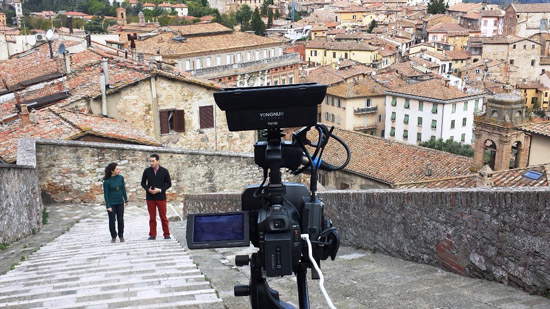This month we take you on a journey of discovery through Umbria’s capital city to the rhythm of jazz. Relax, make yourself comfortable and enjoy this episode: savor the art kept in the National Gallery, the architecture of the mighty city palaces and the green landscape that surrounds the city of Perugia. All this on the typical jazz melodies that just in July enchant Perugia and the whole region: it is the month of Umbria jazz.
The Umbrian capital is probably the oldest municipality in Italy, it stands on several hills and its narrow streets, alternating with steep alleys and stairways, radiate from the center (Piazza IV Novembre) to the outlying villages. The five regal streets, passing under the gates that open into the walls, trace a star-shaped conformation in the urban fabric.
The city center is dominated by the grandiose Palazzo dei Priori, seat of the municipality as well as the ancient guilds, such as the Collegio del Cambio and the Collegio della Mercanzia. In the <a href=’https://www.finestresullarte.info/musei-d-italia/2013/06-perugia-galleria-nazionale-dell-umbria.php target=’_blank’>National Gallery</a> on the top floors a rich collection of Umbrian art with paintings by <a href=’https://www.finestresullarte.info/Puntate/2013/11-perugino-pietro-vannucci.php’ target=’_blank’>Perugino</a>, <a href=’https://www.finestresullarte.info/Puntate/2013/03-pinturicchio-bernardino-di-betto.php’ target=’_blank’>Pinturicchio</a>, <a href=’https://www.finestresullarte.info/Puntate/2014/11-duccio-di-buoninsegna.php’ target=’_blank’>Duccio</a>, <a href=’https://www.finestresullarte.info/Puntate/2009/02-piero-della-francesca.php’ target=’_blank’>Piero della Francesca</a>, <a href=’https://www.finestresullarte.info/Puntate/2009/18-beato-angelico.php’ target=’_blank’>Beato Angelico</a>, Sassoferrato, just to name a few.</p> <p style=’text-align:center’><table class=’images-ilaria’><tr><td><img src=’https://www.finestresullarte.info/review/images/2015/364/palazzo-dei-priori.jpg’ alt=’Palazzo dei Priori’ title=’Palazzo dei Priori’ /></td></tr><tr><td>Palazzo dei Priori</td></tr></table></p> <p> Opposite the palace stands the equally imposing Cathedral inside of which is unexpectedly housed Mary’s wedding ring. It is only by descending into the basement, however, that one can fully appreciate the historical stratification of Perugia, which wanted - on the highest hill of the city - an Etruscan temple in ancient times, then the Roman civilization and then the ledification of the city’s main religious building in medieval times.</p> <p style=’text-align:center’><table class=’images-ilaria’><tr><td><img src=’https://cdn.finestresullarte.info/rivista/immagini/2015/364/cattedrale.jpg’ alt=’The side of the Cathedral with the bronze statue of Pope Julius III made by Vincenzo Danti’ title=’The side of the Cathedral with the bronze statue of Pope Julius III made by Vincenzo Danti’ /></td></tr><tr><td>The side of the Cathedral with the bronze statue of Pope Julius III made by Vincenzo Danti</td></tr></table></p> <p> <p>The Middle Ages is certainly the period that has left the most visible traces in the city, both in architecture and in works of art. The major fountain itself, in the square, is not only a most valuable ornament (with sculptures by <a href=’https://www.finestresullarte.info/Puntate/2013/10-nicola-pisano.php’ target=’_blank’>Nicola</a> and <a href=’https://www.finestresullarte.info/Puntate/2014/01-giovanni-pisano.php’ target=’_blank’>Giovanni Pisano</a>) but a true work of hydraulic engineering, as the end of a path that channeled water from the nearby mountains and brought it into the city. Still visible is the pedestrian via dell’acquedotto built right on the arches of the aqueduct that supplied Perugia.</p> <p>If the Middle Ages left important traces - also worth mentioning are the churches of San Domenico (the largest in Umbria) and that of San Pietro - Perusia’s Etruscan and Roman periods allow us to understand its urban planning: gates (Augustus’s arch in primis), walls and underground Etruscan wells are visible.</p> <p style=’text-align:center’><table class=’images-ilaria’><tr><td><img src=’https://cdn.finestresullarte.info/rivista/immagini/2015/364/arco-di-augusto.jpg’ alt=’Arch of Augustus’ title=’Arch of Augustus’ /></td></tr><tr><td>Arch of Augustus</td></tr></table></p> <p> Perugia was also an important bulwark of the Papal States, Pope Paul III wanted to build an imposing fortress and to do so he destroyed the medieval quarter in which the Baglioni family palaces stood a short time before. The foundations of the Rocca rest on these very buildings, and walking along the underground Via Bagliona today takes us on a journey back in time several centuries. </p> <p>After all, walking around Perugia one is often enchanted by a series of glimpses, views and evocative corners that quench the fatigue of the city’s trekking. For those who then want to overcome more easily the frequent differences in height, know that in the city there are escalators that connect the main public parking lots to the city center, as well as a recent system of light rail called mini-metrò.</p> <p> Perugia is a city suitable for any season, you can immerse yourself in art and landscapes or you can take advantage of its cultural life. Two are the most attended events: the aforementioned Umbria Jazz, which is not limited to the capital but to almost the entire region, and the international chocolate art fair, known as Eurochocolate, which draws millions of people to the city in October.</p> <p> Whether you go there for music, delights or culture, Perugia will surely know how to amaze you; so keep following us, in our company you will not fail to feed on art, history and delicious curiosities. </p> <p> Question 1: What are the <em>Statuta Bernardiniana</em>? <br /> Question 2: Who was Pietro di Cristoforo Vannucci?<br /> Question 3: What is the <em>Studium Perusinum</em>?<br /> </p> <p> Curiosity, speaking of chocolate: the brand the city is inextricably linked to is Perugina, founded in 1907, and the famous Kiss, created in 1922, made it famous worldwide.</p> <p style=’text-align:center’><table class=’images-ilaria’><tr><td><img src=’https://cdn.finestresullarte.info/rivista/immagini/2015/364/san-domenico.jpg’ alt=’The Church of St. Dominic’ title=’The Church of St. Dominic’ /></td></tr><tr><td>The Church of St. Dominic</td></tr></table></p> <p style=’text-align:center’><table class=’images-ilaria’><tr><td><img src=’https://cdn.finestresullarte.info/rivista/immagini/2015/364/via-dell-acquedotto.jpg’ alt=’The Street of the Aqueduct’ title=’The Street of the Aqueduct’ /></td></tr><tr><td>The Street of the Aqueduct
 |
| Fabrizio struggling with... shooting on the aqueduct street |
 |
| St. Peter’s Church |
Warning: the translation into English of the original Italian article was created using automatic tools. We undertake to review all articles, but we do not guarantee the total absence of inaccuracies in the translation due to the program. You can find the original by clicking on the ITA button. If you find any mistake,please contact us.